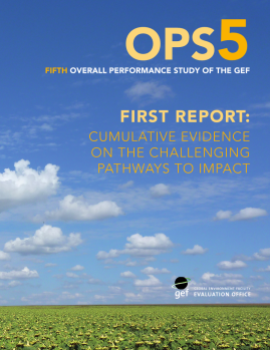Replenishments of the Global Environment Facility (GEF) are informed by periodic assessment of and reflection on GEF achievements and results through independent overall performance studies (OPSs), of which this is the fifth: OPS5. OPS5 reporting will consist of this First Report provided to the first replenishment meeting in April 2013 and a final report to the third meeting.
In accordance with the provisions of the GEF Instrument, particularly Articles 14a and 15, and the overall objectives of previous OPSs, OPS5 aims to assess the extent to which the GEF is achieving its objectives and to identify potential improvements.
Conclusions
- Global environmental trends continue to spiral downward.
- Global environmental problems continue to be underfunded.
- Compared to the international benchmark norm of 75 percent, more than 80 percent of GEF projects completed during GEF-4 and GEF-5 achieved outcome ratings of moderately satisfactory or higher.
- More than 70 percent of completed projects show positive environmental impacts, mostly at the local scale.
- The approaches supported by the GEF have resulted in the reduction of environmental stress at the local scale. GEF support is also contributing to legal, regulatory and Institutional changes at higher scales, but improvements in environmental status at these scales requires a much broader adoption of the promoted approaches and technologies.
- The overall level of GEF responsiveness to convention guidance is high at both the strategic and portfolio levels.
- GEF support at the country level is well aligned with national priorities, shows progress toward impact at the local level, and enables countries to meet their obligations to the conventions.
- GEF support to countries rates well on indicators for meeting the Paris Declaration and outperforms bilateral and multilateral donors on alignment with national priorities.
- Evidence from several evaluation streams points to the emergence of multi-focal area projects and programs as a strong new modality of the GEF. This poses challenges for the formulation of strategies for GEF-6.
- impact and country-level evidence show that there is scope for improving progress toward impact by incorporating broader adoption strategies in project and program design.
Recommendation
- The replenishment meeting should request the Secretariat develop strategies for GEF-6 that would strengthen efforts toward broader adoption and would focus on more programmatic multifocal area approaches, within the guidance of the conventions.
